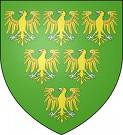
I got this book after my visit to the National Portrait Gallery. It's called England's Queens and subtitled 'the private lives of....'. It's basically a biography of all the Queens of England, which is a real task for any writer - especially over about 450 pages. I've read a couple of Norton's books before, most notably on the wives of Henry VIII, particularly Anne Boleyn. They are very readable, but contain no real new information, and are a straight forward narrative of their lives. This seems to follow the previous books. So far, I've only read the very short chapter on Isabella, consort of Edward II - for obvious reasons! Nothing new in her mentions of Piers Gaveston - all the well-known incidents are there. Norton mentions Isabella marrying Edward II and seemingly not knowing anything about Gaveston. This always intrigues me because surely the French court must have known Edward 1st had banished Gaveston because of the closeness between his son and Piers. The story of Piers receiving the wedding jewels and wearing them at the wedding feast is retold, with the out-raged uncles being furious. Norton believes that Edward and Piers were lovers, but she mentions Edward having an illegitimate son, and takes the view that Isabella accepted the relationship between Edward and Piers as Piers was no threat to her, and the fact that she was pregnant while Piers was still alive is evidence that she lived a 'normal' married life with Edward and Piers' influence didn't stop her husband from having sex with her. That's refreshing! She exonerates Isabella from any plots against Piers, and doesn't make any suggestion that Edward and Piers abandoned Isabella in their flight - merely that they split up to ensure Piers' survival.
Much is made of the animosity between Isabella and Hugh Despencer. Norton believes Edward II was murdered, and that Isabella had a hand in it. She also repeats the tale of Isabella being married in her wedding dress, to show remorse for murdering her husband, and says that Isabella was buried in the same Greyfriars church as Mortimer - I can hear Kathryn's snort from here:)
I shall read the rest of the book, but I think it will be a case of dipping in and out of it.







